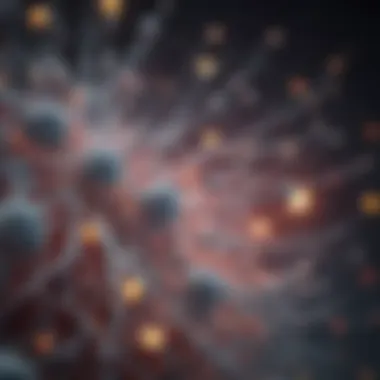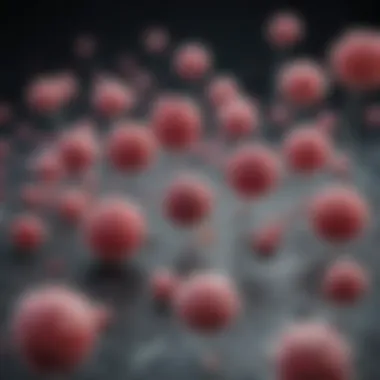Immortal Human Cell Lines: Insights and Implications


Intro
Immortal human cell lines have transformed the landscape of biomedical research, providing a unique resource for scientists aiming to gain insights into human biology. These cell lines, created through methods that induce indefinite replication, allow researchers to conduct experiments over extended periods without the challenges associated with typical cell cultures that lose viability over time. By understanding the characteristics and applications of immortal cell lines, one can appreciate their role in significant scientific advancements.
In recent years, discussions surrounding these cell lines have become more pertinent. Ethical considerations play a key role, especially regarding their origin and the implications of their unbounded growth. Moreover, the scientific community must navigate the societal impacts of using these cell lines in developing therapies and conducting experiments. The objective of this article is to unpack these complexities, shedding light on the mechanics behind immortal human cell lines while assessing their benefits and risks in the scientific arena.
Prelims to Immortal Human Cell Lines
Immortal human cell lines play a crucial role in modern biomedical research. Their ability to proliferate indefinitely makes them invaluable for various applications, from drug discovery to cancer research. These cell lines allow for consistent experimental conditions, which are essential in scientific studies. By understanding the mechanisms that underlie their immortality, researchers can harness their potential more effectively.
Definition and Characteristics
Immortal human cell lines are derived from human tissues and modified to bypass the normal cellular mechanisms that trigger senescence, the process where cells stop dividing. Their key characteristics include:
- Unlimited Proliferation: Unlike normal cells, immortal cell lines can divide indefinitely under controlled laboratory conditions.
- Stability: They maintain genetic characteristics over multiple generations, which allows for reproducibility in experiments.
- Adaptability: They can be cultured in various media and conditions, making them versatile for different research needs.
These traits make immortal cell lines a staple in biological research, as they provide a consistent and reliable resource for scientists.
History of Immortalization
The concept of immortalization began in the early 20th century but gained significant traction with the development of specific techniques. The first widely recognized immortal cell line, HeLa, was derived from cervical cancer cells of Henrietta Lacks in 1951. This marked a key turning point in biological research.
Since then, various methods have been developed to create immortal human cell lines, including:
- Chemical Treatment: Certain chemicals can induce immortality by altering cellular mechanisms.
- Viral Infection: Oncogenic viruses, like SV40 or HPV, can integrate into the host genome, leading to unregulated cell growth.
- Genetic Manipulation: Techniques such as CRISPR allow for precise modifications, enhancing cellular lifespan and growth capabilities.
Immortalization has brought breakthroughs in understanding cancer biology and has propelled advancements in drug development. However, the history of these cell lines also raises several ethical questions that continue to be relevant today.
Mechanisms of Immortality
The mechanisms of immortality in human cell lines are foundational to their functioning and significance. Understanding these mechanisms elucidates how these cells can bypass normal biological processes that lead to cell aging and eventual death. Immortalization is not merely a scientific curiosity; it plays a crucial role in modern research and therapy. Immortal cell lines offer consistent and replicable sources for various applications, enhancing the reliability of experimental outcomes.
Telomerase Activation
A pivotal mechanism in the immortality of cell lines is telomerase activation. Telomeres are protective caps at the ends of chromosomes that shorten each time a cell divides. Eventually, the telomeres become too short, triggering cellular aging or senescence. However, in many immortal cell lines, telomerase—an enzyme that elongates telomeres—is upregulated. This activation allows cells to maintain telomere length and proliferate indefinitely. HeLa cells are a prime example, as they exhibit high telomerase activity, allowing them to divide without the constraints of normal cellular aging.
Understanding telomerase mechanism holds promise for therapeutic applications. In cancer biology, for instance, the activation of telomerase in tumor cells offers insight into tumor growth. Researchers are exploring ways to target this enzyme to potentially halt tumor progression.
Genetic Modifications
Another significant aspect of cellular immortality involves genetic modifications. Through various techniques such as gene editing and transfection, researchers can introduce genes that promote continuous growth and division. For instance, the introduction of oncogenes, which promote cell division, or the inhibition of tumor suppressor genes can lead to immortalization.
Certain immortal cell lines, like HEK293, were derived from human embryonic kidney cells and have been genetically altered to enhance their growth properties. The engineered cells can provide insights into normal and pathological processes, aiding in drug development, gene therapy, and vaccine production. Genetic modifications can lead to a better understanding of diseases and contribute to the development of innovative treatment strategies.
Avoidance of Apoptosis
Apoptosis is a programmed cell death mechanism, serving as a natural barrier to uncontrolled cell growth. Immortal human cell lines often exhibit alterations that allow them to evade apoptosis. This scenario typically involves mutations in genes such as p53, a key regulator of the apoptotic process. By bypassing this protective mechanism, immortal cells can continue to proliferate, even under conditions that would normally trigger cell death.


The study of how immortalized lines evade apoptosis is essential for cancer research. Many cancer cells show similar evasion strategies, leading to their survival and proliferation despite adverse conditions. Understanding the apoptotic pathways can not only enhance cancer therapeutics but also informed biomanufacturing processes within fields like biotechnology.
In summary, the mechanisms of immortality are multifaceted and are crucial for the utility of immortal cell lines in research and therapy. From telomerase activation to genetic modifications and the avoidance of apoptosis, these characteristics provide insight into both fundamental biology and applied medical science.
Applications in Research
Immortal human cell lines have become a cornerstone in biological and medical research. Their ability to proliferate indefinitely offers unique advantages that traditional cell cultures cannot replicate. With applications spanning various fields, these cell lines provide significant insights that drive innovation in drug development, cancer research, toxicology studies, and genetic molecular studies. Understanding these applications not only reveals the metabolic and genetic complexities of human cells but also paves the way for breakthroughs in therapies and treatments.
Drug Development
In the landscape of drug development, immortal human cell lines play a pivotal role. They serve as reliable models for screening potential drug candidates. By utilizing these cell lines, researchers can evaluate the efficacy and safety of new compounds without the immediate ethical concerns associated with animal testing.
The process typically involves:
- Assessing cellular response to various drugs,
- Identifying toxic effects,
- Understanding mechanisms of action.
One notable feature is the ability to manipulate these cell lines genetically, allowing scientists to engineer specific pathways that might react similarly to human physiology. For instance, HEK293 cells are often used for producing viral vectors, crucial for gene therapy research.
Cancer Research
Cancer research heavily relies on immortal human cell lines. They facilitate exploration of tumor biology, drug resistance, and metastasis. By studying these cells, scientists can mimic cancerous growth and investigate the factors that contribute to its development.
This application is significant due to factors such as:
- Generation of tumor cell lines that retain characteristics of original tumors,
- Investigating signaling pathways associated with cancer progression,
- Discovering new target molecules for therapy.
For example, HeLa cells, derived from cervical cancer, have contributed vastly to understanding cancer mechanisms. They are extensively used to study the effects of treatments on cancer cells and provide insights that can lead to new therapeutic strategies.
Toxicology Studies
Understanding the toxic effects of chemicals is vital for public health and safety. Immortal human cell lines are essential in toxicology studies, as they allow researchers to assess the effects of various substances on human-like cells.
These studies often include:
- Screening for cytotoxic effects,
- Evaluating the potential for mutagenicity,
- Assessing organ-specific toxicity.
Utilizing cell lines reduces the need for animal testing and adheres to ethical standards. Furthermore, the results from such studies can help predict human responses to toxic exposures, enhancing product safety in pharmaceuticals and consumer products.
Genetic and Molecular Studies
Immortal human cell lines also prove beneficial in genetic and molecular studies. They provide a consistent platform for exploring gene function, expressing recombinant proteins, and studying genetic diseases. These cell lines enable researchers to:
- Perform CRISPR-Cas9 gene editing to study gene function,
- Analyze gene expression patterns in various conditions,
- Investigate the role of specific proteins in cellular pathways.
The use of these lines, such as MDCK cells, allows for significant advancements in understanding cell signaling, protein interactions, and biological responses at the molecular level.
"The ability to manipulate immortalized cell lines for genetic studies provides insights that are crucial for advancements in genetic therapies and understanding pathophysiological mechanisms."


Popular Immortal Human Cell Lines
Immortal human cell lines serve as foundational tools in biological and medical research. Their ability to replicate indefinitely allows researchers to conduct long-term experiments without the constraints associated with primary cells, which have a limited lifespan. This section focuses on three of the most noteworthy immortal human cell lines: HeLa cells, HEK293 cells, and MDCK cells. Understanding these cell lines is crucial as they have different characteristics and applications that benefit various areas of research.
HeLa Cells
HeLa cells were the first immortal cell line ever developed, originating from Henrietta Lacks in 1951. These cells became notable for their robust nature and ability to divide indefinitely. HeLa cells are particularly significant because they have been used in numerous medical breakthroughs, including the development of the polio vaccine, cancer research, and studies in gene mapping.
The importance of HeLa cells extends beyond their scientific contributions. Ethical debates surrounding the use of these cells without informed consent have sparked discussions on bioethics. Nevertheless, their role in advancing science is invaluable. Researchers frequently turn to HeLa cells for studies related to cancer biology and viral propagation, especially due to their unique genetic characteristics, which can affect experimental outcomes.
HEK293 Cells
HEK293 cells are another prominent immortal human cell line derived from human embryonic kidney cells. Originally transformed with adenoviral DNA, they provide a versatile platform for various applications. Nonetheless, HEK293 cells are renowned for their efficiency in protein expression and gene transfer studies.
Their utility is particularly pronounced in biopharmaceutical development and transfection studies. Scientists often utilize HEK293 cells to produce viral vectors used in gene therapy and vaccine production. The cells are easy to culture and manipulate, contributing to their popularity in laboratory settings. At the same time, ethical considerations regarding their derivation from fetal tissue have been raised, prompting discussions on the source and application of such cell lines in modern research.
MDCK Cells
MDCK cells (Madin-Darby Canine Kidney cells) are derived from the kidney of a dog but are categorized under popular immortal cell lines for their significant use in human-related studies. These cells are distinguished for their ability to form tight junctions and polarize, making them ideal for studying epithelial functions.
The application of MDCK cells is notable in virology, particularly in the study of influenza viruses. Their ability to support viral replication facilitates research on virus behavior and potential treatments. Furthermore, MDCK cells are commonly used to test drug permeability, assisting in the development of better pharmaceutical compounds. Although not human-derived, their relevance in human health and disease makes them a critical component in biomedical research.
"Immortal cell lines, like HeLa, HEK293, and MDCK cells, are indispensable in advancing our understanding of complex biological processes. Their unique properties enable researchers to unravel the intricacies of disease mechanisms while raising ongoing ethical considerations."
In summary, each of these immortal human cell lines plays a pivotal role in the landscape of biomedical research. HeLa cells have historical significance and contribute profoundly to cancer research and vaccine development. HEK293 cells offer unparalleled advantages in gene therapy and bioscience, while MDCK cells provide invaluable insights into viral studies and drug testing. Recognizing their contributions and considerations is essential for any professional engaged in research.
Ethical Considerations
The use of immortal human cell lines poses significant ethical questions that require careful contemplation. These considerations are essential in guiding the responsible application of these robust tools in research and development. Key ethical concerns include the necessity of informed consent, questions around ownership of biological materials, and how these factors may impact research integrity.
Informed Consent
Informed consent is a cornerstone of ethical research practices. This process ensures that donors understand the implications of their contributions. When utilizing immortal human cell lines, researchers often rely on cells derived from human tissues. Obtaining explicit consent from donors is crucial, particularly in cases where cell lines may be used for multiple purposes, including commercial applications. Participants should be fully aware of how their biological materials might be employed. Failure to adequately address the informed consent process can lead to public mistrust, which may hinder scientific progress.
Ownership of Biological Materials
The question of ownership is another complex issue. When individuals donate cells or tissues, who retains the rights to these materials? Typically, donors relinquish ownership upon contributing their samples. However, this raises ethical dilemmas, especially if the resulting cell lines generate significant profits. Researchers and institutions must navigate these waters carefully, ensuring fair compensation and recognition of contributions while honoring the dignity of the original donors. This conversation extends to discussions about profit-sharing and how ethically to manage the commercialization of research products derived from human cells.
Impact on Research Integrity
The ethical considerations surrounding immortal human cell lines extend beyond mere compliance and procedural formality; they significantly influence research integrity. When ethical standards are not met, the validity of findings may come under scrutiny. Research that lacks transparency often results in public skepticism, which can undermine funding and support for future projects. Moreover, unethical practices can jeopardize the foundational tenets of scientific exploration—namely, trust and collaboration.
"Ethics are not an optional add-on; they are foundational to conducting research that is credible, reproducible, and respected."
Challenges in Using Immortal Cell Lines
Immortal human cell lines have revolutionized the field of biomedical research, yet their use is not without challenges. Understanding these challenges is crucial for researchers and practitioners who rely on these cell lines for experiments and studies. This section will delve into pertinent aspects, including genetic drift and the lack of tissue-specific characteristics. By exploring these issues, we can gain insights into the limitations of immortal cell lines and consider their implications for research outcomes.


Genetic Drift
Genetic drift refers to the random changes in the frequencies of alleles within a population. In immortal cell lines, this phenomenon can lead to alterations in genetic characteristics over prolonged periods. As these cells divide and proliferate, stochastic events can cause variations in their genetic makeup, potentially impacting their behavior and properties.
This variability poses a significant concern. For example, a cell line initially characterized by specific characteristics, such as drug response or metabolic activity, may evolve differently over time. Researchers may find that results obtained from experiments involving these lines may not be reproducible due to genetic drift. If genetic drift goes unnoticed, it can result in misinterpretation of experimental data, leading to false conclusions and potentially flawed therapeutic directions.
Lack of Tissue-Specific Characteristics
Another major challenge with immortal cell lines is their lack of tissue-specific characteristics. Unlike primary cells, which retain the unique features of the tissue they originate from, immortalized cell lines often lose these distinctive traits. This is significant for research aimed at understanding complex biological processes or diseases that are tissue-specific.
The absence of tissue-specific features can hinder the applicability of findings in real biological systems. For instance, a cancer drug tested on a breast cancer cell line may show efficacy in vitro but may not translate to actual patient outcomes. Factors such as microenvironment, hormonal influences, and interactions with other cell types are overlooked when using immortalized cell lines, resulting in reduced relevance in clinical contexts.
"Understanding the challenges posed by immortal cell lines is crucial for interpreting results and translating research into practice."
In summary, while immortal human cell lines present numerous advantages for research, the challenges they present must not be ignored. Genetic drift and the lack of tissue-specific characteristics can significantly affect the validity and applicability of research findings. Researchers must be aware of these challenges and take them into account while conducting experiments and interpreting results.
Future Directions
As the landscape of biomedical research continues to evolve, the future directions of immortal human cell lines are becoming increasingly pertinent. These cell lines serve as powerful tools in various research fields. Understanding their potential advancements can lead to significant strides in not just scientific exploration but also clinical applications. This section discusses crucial elements related to advancements in cell engineering and integration with organoid technology, both of which herald new opportunities in research and therapy.
Advancements in Cell Engineering
Recent years have witnessed remarkable advancements in cell engineering techniques. Innovations such as CRISPR-Cas9 gene editing and synthetic biology have enabled researchers to modify immortal human cell lines with precision. These methods allow the introduction of specific genetic changes that can enhance the utility and functionality of these cells in research. For instance, the development of reporter cell lines that express fluorescent proteins provides visual indicators of cellular processes.
Moreover, advancements in cell reprogramming technologies have opened up pathways for creating induced pluripotent stem cells (iPSCs) from differentiated adult cells.
- Benefits of these advancements include:
- Greater control over cellular behavior
- Improved modeling of diseases
- Enhanced drug screening processes
Such advanced cell engineering techniques promise to bridge gaps between basic research and clinical applications, potentially leading to more effective therapies for various diseases.
Integration with Organoid Technology
Organoid technology represents a frontier in biomedical research. By creating three-dimensional structures that mimic the architecture and functionality of actual tissues, organoids provide an invaluable model for studying biology in a more physiological context. The integration of immortal human cell lines into organoid models can significantly enhance their biological relevance.
Utilizing immortal human cells to generate organoids enables researchers to:
- Model diseases more accurately by incorporating genetic backgrounds of specific cell lines.
- Test drug responses in a setting that more closely resembles human tissues, which can yield more reliable data than traditional monolayer cultures.
- Investigate cellular interactions within a three-dimensional environment, shedding light on complex tissue dynamics.
The convergence of immortal cell lines and organoid technology exemplifies an important trajectory for future research. It presents a compelling approach to studying human biology and disease mechanisms more thoroughly.
"Integrating immortal human cell lines with organoid technology could redefine personalized medicine by allowing for patient-specific models that inform treatment options."
Finale
The study and usage of immortal human cell lines carry significant importance in the realm of scientific research. These cell lines provide a reliable platform for various investigations, biotechnological advancements, and medical breakthroughs. They enable researchers to explore fundamental biological processes, develop therapies, and test pharmaceuticals. The implications of utilizing immortalized cell lines are vast, influencing areas such as drug discovery, cancer research, and toxicology.
Summary of Key Points
- Immortal human cell lines can reproduce indefinitely, providing a constant supply of cells for research.
- They are pivotal in understanding cellular mechanisms and diseases, particularly cancer.
- Despite their benefits, researchers must confront ethical issues, including informed consent and ownership of biological materials.
- Potential challenges like genetic drift could affect the efficacy of results derived from these cells.
Implications for Future Research
Investigating immortal human cell lines opens up numerous avenues for future research. As science progresses, integrating advanced techniques like gene editing could further enhance the usefulness of these cell lines. The incorporation of organoid technology holds promise for creating models that more closely mimic human biology. This can help bridge the gap between in vitro studies and real-world applications. Moreover, continual improvement in ethical practices surrounding the procurement and use of these cells is essential to maintain integrity in research. Future studies will likely focus on developing more accurate models for drug testing and disease modeling, paving the way for innovative therapies.



